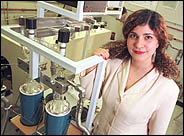Parisa Ariya
| Parisa Ariya describes herself as a private person who wants to avoid publicity, but that may be easier said than done.
 PHOTO: OWEN EGAN
PHOTO: OWEN EGAN
| |
As a young female scientist who came to McGill fresh from a postdoctoral fellowship with a Nobel laureate, and with research projects in a field of considerable public interest, she may find the limelight seeks her out anyway.
Those projects could eventually make important contributions to our understanding of the Earth's atmosphere. Ariya, an assistant professor in the departments of Chemistry and Atmospheric and Oceanic Sciences, is investigating three major environmental issues: acid rain, cancer-causing particles in the atmosphere, and compounds that may affect greenhouse gases.
Ariya arrived here a year-and-a-half ago after turning down much more lucrative salary offers from the United States. She explains that she came to McGill for personal reasons: she was born in Tehran and grew up in eight countries. When she was 14, her family moved to Toronto. With friends and family in eastern Canada, she says that, by choosing McGill, "I felt like I was coming back home."
She studied both chemistry and physics at York University before getting her PhD in 1996 at York's Centre for Atmospheric Chemistry. Then she went to the Max Planck Institute in Germany, where she did postdoctoral work with Paul Crutzen, the scientist who, in 1970, demonstrated how selected chemicals were destroying the Earth's protective ozone layer.
One of her main research aims is to solve a mystery about the formation of acid rain. When sulfur dioxide goes into the air, the sulfur is in a harmless form; however, if it is oxidized, it becomes sulfur VI, the kind of sulfur found in acid rain.
She and Crutzen wrote a theoretical paper in which she proposed a new mechanism that could help explain how this transformation occurs. This mechanism involves reactions between alkenes (hydrocarbon compounds such as ethylene from both human activities and natural sources) and ozone in the atmosphere. "My lab is involved in evaluating that hypothesis," she says.
Her newest research project involves aerosol particles that can cause cancer. These particles originate as molecules emitted by organic pollutants such as pesticides and fertilizers. She wants to understand how these molecules are transformed until they reach the body.
"Besides the impact on health, most water pollution — in Ontario lakes, for example — comes from atmospheric deposition of particles" by wind and rain, she adds.
Ariya's third major field of interest addresses the role of trace compounds on the production and destruction of greenhouse gases such as ozone. She is focusing on halogens (elements such as chlorine and bromine) which may play important roles in removing hydrocarbon pollutants from the atmosphere, although the products formed by these reactions may be toxic. The objective is to find out what kinds and concentrations of reactive halogens are in the atmosphere, where they come from, and what reactions take place.
Although she focuses on laboratory studies, Ariya and her 14-member team also conduct field works and theoretical studies, and they are collaborating on these projects with other investigators at McGill, in Canada, the U.S. and abroad.
Both her departmental chairs, atmospheric and oceanic sciences professor Charles Lin and chemistry professor David Harpp, point to Ariya as a star in the making. Ariya established the first atmospheric chemistry laboratory in a Quebec university, securing $1 million in funding from federal and provincial granting agencies.

